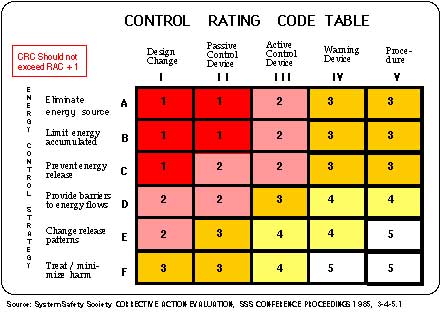|
|
INVESTIGATION CATALYST Recommendation Developmen Tutorial © 2004 by Starline Software Ltd. |
|
RANKING ACTION OPTIONS
The first task in evaluating candidate options that might be recommended is to analyze their relative potential effectiveness for improving future performance. After that attribute has been analyzed, the next task is to analyze the tradeoffs needed to rank and arrive at the most desirable option. |
Analyze Options |
Investigation Catalyst provides default entries for analyzing each of the candidate options to fix the problem. The defaults include the existing risk from the problem assessment task, the intervention phase and type of control to ensure its appropriateness for the risk level to be controlled, the new risk level when implemented, and the estimated feasibility of monitoring implementation. Other analysis criteria can be substituted by changing the names of the application defaults in the Tools menu. Those intervention entry phase and type of control entries represent
The control rating evaluation matrix, shown below, can be used to guide the evaluation. The matrix includes numbers in the squares which refer to the Risk Assessment Code (RAC) rating from the problem evaluation task. The color coding helps identify the kinds of changes that need to be introduced for the level of risk posed by the problem being fixed. For example, using the defaults system, a high "RAC 1" risk should to be controlled in one of five ways, listed in the order of preference:
Note that all these changes exclude the need for action by an operator, which is appropriate for an attempt to eliminate or very substantially reduce a high risk. On the other hand, actions that involve operators might be very suitable for lower rated risks. |
Compare New Risk Levels |
To compare the relative effectiveness of the options for changes, the estimated risk levels provide one of the best indicators. The new Risk value can be derived from the table after the phase of the problem attacked by the change and type of change are established. If the defaults are changed, be sure to identify the expected new risk level after the change is implemented, using the same basis used to identify the current risk level. |
Assess Follow up Feasibility |
Options that can not be monitored to confirm their expected performance improvement should be avoided. Thus, the next option analysis task is to estimate the feasibility of the monitoring operations for success after implementation. Feasibility is determined by the ability to define the new interactions after the option is implemented, and the ability to observe, document and interpret those interactions. Analysts can develop reasoned estimates of the likelihood that the feasibility can be monitored successfully, and rate that likelihood on a 3 or 5 level scale, with 5 being very likely to be feasible, and 1 being very unlikely to be feasible. This can be done informally by thinking about how the changes would alter the process described in the matrix, and what data would tell everyone that the change was successful in achieving the desired results. At this stage, judgments about the feasibility of capturing and documenting those data are acceptable.
For high-cost or high-stakes changes, documenting and analyzing the new expected system operation with Investigation Catalyst to demonstrate that the new operation will produce the expected results, and how to confirm those results, might be necessary as part of the "selling" tasks for the acceptance of the recommended actions. The follow up plan should be developed after a preferred option has been selected. |
